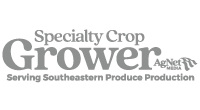

By Tripti Vashisth and Mary Sutton
HLB-affected trees have small and weak root systems. These trees often experience water and nutrient deficit. However, not all HLB-affected trees experience the same impact. Trees with severe HLB symptoms will have higher root loss and water deficit than trees with mild HLB symptoms.
The water deficit exacerbates during spring, which is often the low rainfall period in Florida and coincides with significant growth in trees. Flowering, fruit set, fruit growth and leaf growth require high water availability. The growth of fruit can be attributed to cell division and enlargement, which increases the number and size of cells, respectively, during the first two months following the beginning of fruit set (stage I of fruit development) and about four to six months thereafter (stage II). Fruit size increases rapidly because of water accumulation in cells during fruit development. Additionally, there is a link between fruit size and fruit drop. Small fruit are more prone to drop from the tree than large fruit.

In an experimental field trial for two consecutive years, University of Florida Institute of Food and Agricultural Sciences (UF/IFAS) researchers found that frequent irrigation produced more than double yield (Figure 1) than conventional irrigation (every other day irrigation). The two treatments received the same amount of water over time but differed in how often they received water and how much water they received at a time.
The trees in both treatments had similar canopy volumes and densities before treatments were implemented. At the conclusion of the study, the experimental trees had significantly larger canopies than the control (27 m3 vs. 22 m3). Similarly, the experimental trees had significantly denser canopies than the control (83% vs. 75% light interception). In citrus, canopy density and health is often determined by measuring the amount of light that is intercepted by the canopy. The more light that is intercepted, the denser the canopy.
Adequate water supply during spring and early summer (low rainfall period) is critical to ensure uninterrupted fruit development and growth for better fruit retention. The more well-watered status of frequently irrigated trees is likely to contribute to higher reproductive and vegetative growth and significantly higher yields.
Tripti Vashisth is associate center director and associate professor at the UF/IFAS Citrus Research and Education Center in Lake Alfred. Mary Sutton is an assistant professor and citrus Extension specialist at the University of Georgia in Tifton.
Share this Post
Sponsored Content










